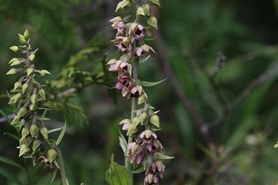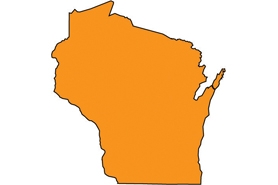Helleborine orchid
(Epipactis helleborine)
Perennial forb in the Orchid family that gets to be 1-3’ tall. Several stems appear and are covered with a sparse woolly hair.
Other names for this plant include:
- Common names: broad-leaved helleborine
- Scientific names: Amesia latifolia; Epipactis latifolia; Serapia helleborine
Classification in Wisconsin: Restricted
- Ecological Threat
-
- Found in deciduous forests where there is limestone bedrock.
- May have limited distribution due to specialized mycorrhizae fungi relationship.
- Identification
-
Leaves: Many (3-30), alternate, clasping, oval-elliptical, prominent parallel veins.
Flowers: 6-parted, the lip is green-purple; petals and sepals dull green with purple veins; 4-12” one-sided raceme; bracts below flowers are longer than the petals; bloom July-August; flowers are nodding.
Fruits & seeds: Egg-shaped capsules.
Roots: Tightly clustered fibrous roots.
- Control
-
Mechanical: Hand pulling is effective in controlling this species.
Chemical: Not needed.
- Resources
- Sources for content:
- Czarapata, Elizabeth; Invasive Plants of the Upper Midwest: an illustrated guide to their identification and control. University of Wisconsin Press. 2005. Pg. 104-105
- Hapeman, Jeffery. Orchids of Wisconsin: Epipactis helleborine [exit DNR].
- Ogura-Tsujita, Yuki and Yukawa, Tomohisa. Publisher: Springer Berlin/ Heidelberg; ISSN: 0940-6360 (Print) 1432-1890 (Online); Issue: Volume 18, Numbers 6-7/September 2008; Pages: 331-338; Subject Collection: Biomedical and Life Sciences; Tsukuba Botanical Garden, National Museum of Nature and Science, 4-1-1 Amakubo. Tsukuba 305-0005. Japan


